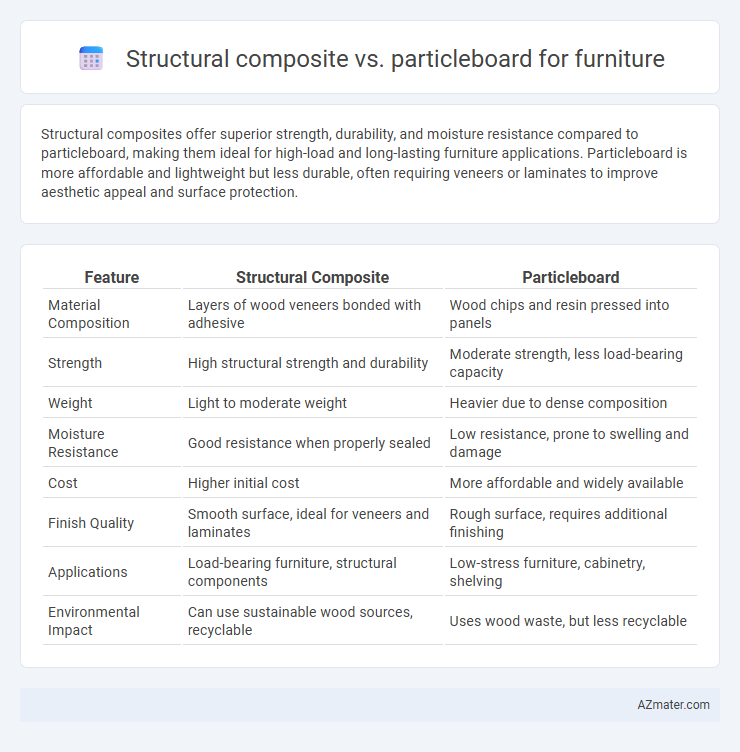Structural composites offer superior strength, durability, and moisture resistance compared to particleboard, making them ideal for high-load and long-lasting furniture applications. Particleboard is more affordable and lightweight but less durable, often requiring veneers or laminates to improve aesthetic appeal and surface protection.
Table of Comparison
| Feature | Structural Composite | Particleboard |
|---|---|---|
| Material Composition | Layers of wood veneers bonded with adhesive | Wood chips and resin pressed into panels |
| Strength | High structural strength and durability | Moderate strength, less load-bearing capacity |
| Weight | Light to moderate weight | Heavier due to dense composition |
| Moisture Resistance | Good resistance when properly sealed | Low resistance, prone to swelling and damage |
| Cost | Higher initial cost | More affordable and widely available |
| Finish Quality | Smooth surface, ideal for veneers and laminates | Rough surface, requires additional finishing |
| Applications | Load-bearing furniture, structural components | Low-stress furniture, cabinetry, shelving |
| Environmental Impact | Can use sustainable wood sources, recyclable | Uses wood waste, but less recyclable |
Introduction to Structural Composites and Particleboard
Structural composites combine multiple materials such as wood fibers, resin, and adhesives to create strong, durable panels used for high-performance furniture applications. Particleboard consists of wood chips, sawdust, and resin compressed into sheets, offering a cost-effective but less durable option suitable for budget-friendly furniture. The choice between structural composites and particleboard hinges on factors like strength requirements, moisture resistance, and budget constraints in furniture manufacturing.
Material Composition and Manufacturing Processes
Structural composite materials, such as plywood and laminated veneer lumber (LVL), consist of multiple layers of wood veneers or fibers bonded together with durable adhesives under heat and pressure, resulting in enhanced strength and stability. Particleboard is manufactured by compressing wood chips, sawdust, and resin into dense panels, offering a cost-effective but less durable alternative with lower resistance to moisture and mechanical stress. The layered construction of structural composites offers superior load-bearing capacity and longevity compared to the homogeneous but porous structure of particleboard.
Strength and Durability Comparison
Structural composite materials, such as plywood and MDF (medium-density fiberboard), generally exhibit greater strength and durability compared to particleboard, making them more suitable for load-bearing furniture applications. Plywood's cross-laminated layers provide enhanced resistance to warping, sagging, and impact, while MDF offers a denser and more uniform surface that holds screws and finishes better than particleboard. Particleboard, though more economical, tends to be weaker and more susceptible to moisture damage and chipping, resulting in reduced longevity in high-stress or high-moisture environments.
Weight and Design Flexibility
Structural composite materials offer a superior strength-to-weight ratio compared to particleboard, making furniture lighter yet more durable for handling and transport. Design flexibility is significantly enhanced in structural composites due to their ability to be molded into complex shapes and customized thicknesses, unlike particleboard which is limited to flat, rigid panels. This versatility enables innovative furniture designs that combine aesthetic appeal with functional performance.
Moisture and Environmental Resistance
Structural composites such as plywood and oriented strand board (OSB) exhibit superior moisture and environmental resistance compared to particleboard, making them more durable for furniture exposed to humidity or variable climates. Particleboard tends to absorb moisture, leading to swelling, warping, and reduced structural integrity, whereas structural composites incorporate resin adhesives and wood veneers that limit water ingress and enhance longevity. Selecting plywood or OSB ensures improved resistance to mold, decay, and degradation, which is critical for maintaining furniture performance in challenging environments.
Cost Efficiency and Affordability
Structural composite materials like plywood and MDF offer superior durability and stability compared to particleboard, making them a cost-effective choice for long-term furniture investment. Particleboard is generally more affordable upfront, appealing for budget-conscious projects, but it tends to have lower moisture resistance and durability, leading to higher maintenance or replacement costs. Evaluating both options by weighing initial price against longevity and usage conditions ensures optimal cost efficiency in furniture construction.
Surface Finish and Aesthetic Qualities
Structural composites offer superior surface finishes with smooth, uniform textures that enhance aesthetic appeal and allow for high-quality painting or laminating, making them ideal for modern furniture designs. Particleboard typically has a rougher surface that requires veneers or laminates to achieve a polished look, often limiting design flexibility and durability. The denser composition of structural composites also provides better resistance to wear and moisture, maintaining furniture appearance over time.
Sustainability and Environmental Impact
Structural composite materials like cross-laminated timber (CLT) offer superior sustainability compared to particleboard due to their use of renewable wood sources and minimal synthetic adhesives, significantly reducing carbon footprint and promoting biodegradability. Particleboard often contains formaldehyde-based resins and recycled wood fibers, which can release volatile organic compounds (VOCs) and contribute to indoor air pollution, making it less environmentally friendly. The durability and recyclability of structural composites further enhance their environmental benefits, supporting circular economy principles in furniture manufacturing.
Application Suitability in Furniture Design
Structural composite materials, such as plywood and MDF, offer superior strength and durability, making them ideal for load-bearing furniture components and high-end cabinetry requiring precise finishes. Particleboard is cost-effective and suitable for budget-friendly furniture pieces with light to moderate use, including flat-pack items and shelving that do not require high structural integrity. Selecting the appropriate material depends on the expected load, aesthetic requirements, and longevity of the furniture design.
Conclusion: Choosing the Right Material for Furniture
Structural composite materials offer superior strength, durability, and resistance to moisture, making them ideal for high-load furniture and long-lasting applications. Particleboard provides a cost-effective and lightweight solution, suitable for budget-conscious projects and furniture with minimal stress requirements. Selecting the right material depends on balancing performance needs, budget constraints, and specific furniture use cases.

Infographic: Structural composite vs Particleboard for Furniture
 azmater.com
azmater.com